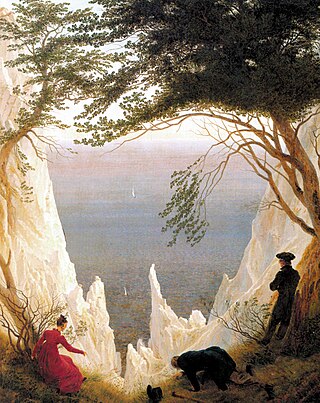Ìgbà Ẹlẹ́fun
From Wikipedia, the free encyclopedia
Remove ads
The Ìgbà Ẹlẹ́fun tabi Ìgbà Ẹfun (Cretaceous) (![]() /krɪˈteɪʃəs/), derived from the Latin "creta" (chalk), usually abbreviated K for its German translation Kreide (chalk), is a geologic period and system from circa 145.5 ± 4 to 65.5 ẹgbẹgbẹ̀rún ọdún sẹ́yìn million years (Ma) ago. In the geologic timescale, the Cretaceous follows the Jurassic Period and is followed by the Paleogene Period of the Cenozoic Era. It is the youngest period of the Mesozoic Era, and at 80 million years long, the longest period of the Phanerozoic Eon. The end of the Cretaceous defines the boundary between the Mesozoic and Cenozoic eras.
/krɪˈteɪʃəs/), derived from the Latin "creta" (chalk), usually abbreviated K for its German translation Kreide (chalk), is a geologic period and system from circa 145.5 ± 4 to 65.5 ẹgbẹgbẹ̀rún ọdún sẹ́yìn million years (Ma) ago. In the geologic timescale, the Cretaceous follows the Jurassic Period and is followed by the Paleogene Period of the Cenozoic Era. It is the youngest period of the Mesozoic Era, and at 80 million years long, the longest period of the Phanerozoic Eon. The end of the Cretaceous defines the boundary between the Mesozoic and Cenozoic eras.
| Ìgbà Ẹlẹ́fun 145.5–65.5 ẹgbẹgbẹ̀rún ọdun sẹ́yìn | |
[[Image: | |
| Mean atmospheric O2 content over period duration | ca. 30 Vol %[1] (150 % of modern level) |
| Mean atmospheric CO2 content over period duration | ca. 1700 ppm[2] (6 times pre-industrial level) |
| Mean surface temperature over period duration | ca. 18 °C[3] (4 °C above modern level)
|
 |
Àyọkà yìí tàbí apá rẹ̀ únfẹ́ àtúnṣe sí. Ẹ le fẹ̀ jù báyìí lọ tàbí kí ẹ ṣàtúnṣe rẹ̀ lọ́nà tí yíò mu kúnrẹ́rẹ́. Ẹ ran Wikipedia lọ́wọ́ láti fẹ̀ẹ́ jù báyìí lọ. |
Remove ads
Itokasi
Wikiwand - on
Seamless Wikipedia browsing. On steroids.
Remove ads
